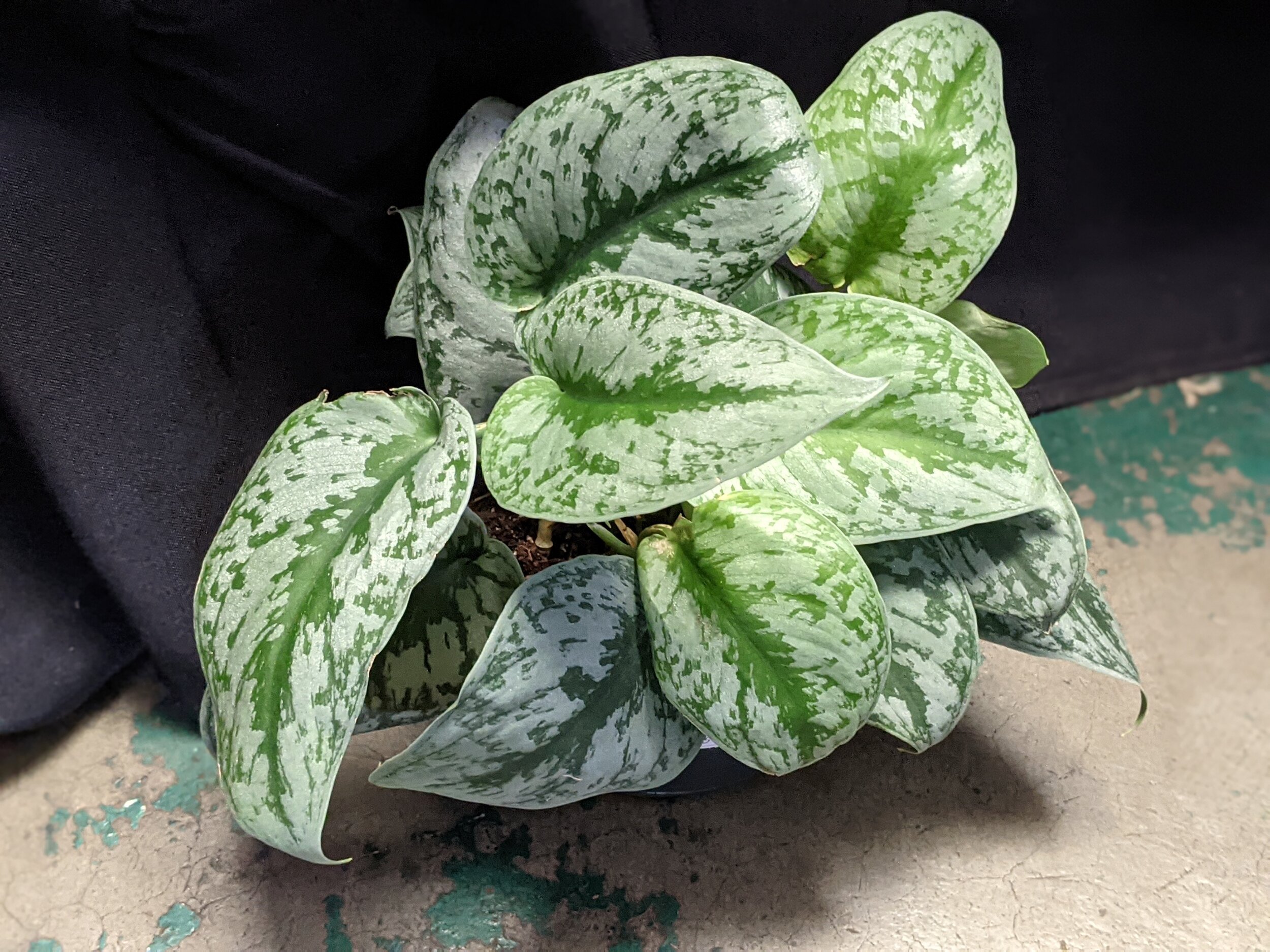The Scindapsus Exotica, a member of the Araceae family, has captivated my heart and home with its unique beauty and surprisingly straightforward care requirements. Here’s a more detailed look into how I ensure my Scindapsus Exotica thrives, making it an ideal plant for both novice and experienced plant enthusiasts.

Ideal Growing Conditions
- Light: This plant prefers medium to bright, indirect light. I’ve found that placing it near a window with a sheer curtain provides the perfect amount of light without risking leaf burn. It’s adaptable but avoids direct sunlight and very dark corners.
- Watering: The watering needs are moderate. I wait until the top inch of the soil feels dry before watering again. Overwatering can lead to root rot, so I ensure the pot has good drainage.
Humidity and Temperature
- Humidity: Scindapsus Exotica enjoys a bit of humidity. In my experience, maintaining a room humidity around 40-50% keeps it happy. I sometimes mist it or use a pebble tray, especially during drier months.
- Temperature: It prefers average room temperatures, around 65°F to 75°F (18°C to 24°C). It’s important to protect it from sudden temperature drops and drafts.
Soil and Fertilization
- Soil: A well-draining potting mix works best. I use a mix containing peat, perlite, and pine bark, which provides good aeration and drainage.
- Fertilizer: During the growing season (spring and summer), I feed it monthly with a balanced, water-soluble fertilizer, diluted to half the recommended strength.
Pruning and Maintenance
- Pruning: To encourage bushier growth, I prune it occasionally. This not only helps the plant look its best but also stimulates new growth.
- Cleaning: I gently wipe the leaves with a damp cloth to remove dust. This not only keeps the plant looking fresh but also allows for better photosynthesis.
Propagation
- Easy to Propagate: One of my favorite aspects of Scindapsus Exotica is how easy it is to propagate. I simply cut a piece of stem with a few leaves and nodes and place it in water. In a few weeks, roots develop, and it can be planted in soil.
Pest Management
- Pests: Like many houseplants, it can be prone to pests like spider mites and mealybugs. I keep an eye out for any signs of infestation and treat them promptly with insecticidal soap or neem oil.
Decor and Styling
- Versatile Display: It’s a versatile plant that looks great in hanging baskets, allowing its trailing vines to cascade down elegantly. Alternatively, training it to climb a moss pole or trellis can create a stunning vertical display.
Toxicity
- Caution with Pets: It’s important to note that Scindapsus Exotica is toxic when ingested, so I keep it out of reach of my pets and children.
The Scindapsus Pictus Exotica, with its velvety, heart-shaped leaves and silver markings, not only adds a touch of exotic elegance to my living space but has also been a joy to care for. Its adaptability to various indoor conditions and ease of maintenance make it an excellent choice for anyone looking to enhance their home with lush, trailing greenery. 🌿🏡
FAQ: Caring for Scindapsus Pictus Exotica 🍃✨
How often should I water my plant?
💧 Watering Routine: Water your Scindapsus Exotica when the top inch of the soil feels dry. Typically, this means watering every 1-2 weeks, but this can vary depending on the light and humidity in your home.
What type of light is best for this plant?
☀️ Light Requirements: Scindapsus Exotica thrives in medium to bright, indirect light. A spot near a window with a sheer curtain is ideal to provide filtered sunlight. Direct sunlight should be avoided as it can scorch the leaves.
How do I know if I’m overwatering my Exotica plant?
🚱 Signs of Overwatering: If leaves become yellow or mushy, or if you notice a musty smell from the soil, these could be signs of overwatering. Ensure good drainage and let the soil dry out more between waterings.
Can this plant purify indoor air?
🌬️ Air Purifying Qualities: Yes, Scindapsus is known for its air-purifying abilities. It can help remove certain toxins from the air, making it not just a beautiful, but also a beneficial indoor plant.
Is Scindapsus Exotica easy to propagate?
🌿 Propagation Ease: Absolutely! Exotica is easy to propagate through stem cuttings. Just cut a piece of stem with a few leaves and nodes, and place it in water or directly into soil. It roots fairly easily.
How do I keep the leaves of Scindapsus Exotica shiny?
✨ Leaf Care: To keep the leaves shiny and healthy, wipe them down occasionally with a damp cloth to remove dust. This not only enhances their appearance but also improves their ability to absorb light.
How fast does Scindapsus Exotica grow?
📈 Growth Rate: Scindapsus is a moderately fast grower. With proper care, you can expect steady growth, especially during the spring and summer months.
What are the common pests that affect Scindapsus Pictus Exotica?
🐜 Pest Control: Watch out for common pests like spider mites and mealybugs. Regularly inspect the leaves, and if pests are detected, treat them with insecticidal soap or neem oil.
Can Scindapsus Exotica tolerate low humidity?
💨 Humidity Tolerance: Scindapsus Exotica can tolerate a range of humidity levels, but it thrives in moderate to high humidity. If your home is very dry, consider using a humidifier or a pebble tray to increase the humidity around the plant.
Is Scindapsus plant safe for pets?
🐾 Pet Safety: Scindapsus Pictus Exotica can be toxic if ingested. It’s best to keep it out of reach of curious pets and small children to prevent any accidental ingestion.
Caring for Exotica is a joy, thanks to its low-maintenance nature and stunning appearance. It’s a fantastic choice for both novice and seasoned plant lovers, bringing a touch of the exotic to any indoor space. 🌱🏠
Introduction
Nicki Mann, based in Portland, Oregon, is a good writer and houseplant enthusiast. With her background in environmental science, Nicki specializes in indoor gardening, focusing on sustainable and organic practices.
Experience
Her interest in houseplants began in her mid-twenties, leading to a career writing articles about indoor plant care and eco-friendly gardening for various websites.
Education
Nicki holds a Bachelor of Science in Environmental Studies from the University of Oregon, which underpins her approach to indoor gardening. She continually enhances her knowledge through horticulture and environmental sustainability workshops.
Personal Life
Nicki, an avid nature lover, enjoys exploring the Pacific Northwest's trails. She's active in community gardening and lives with her two rescue cats, who share her interest in her growing collection of houseplants.


